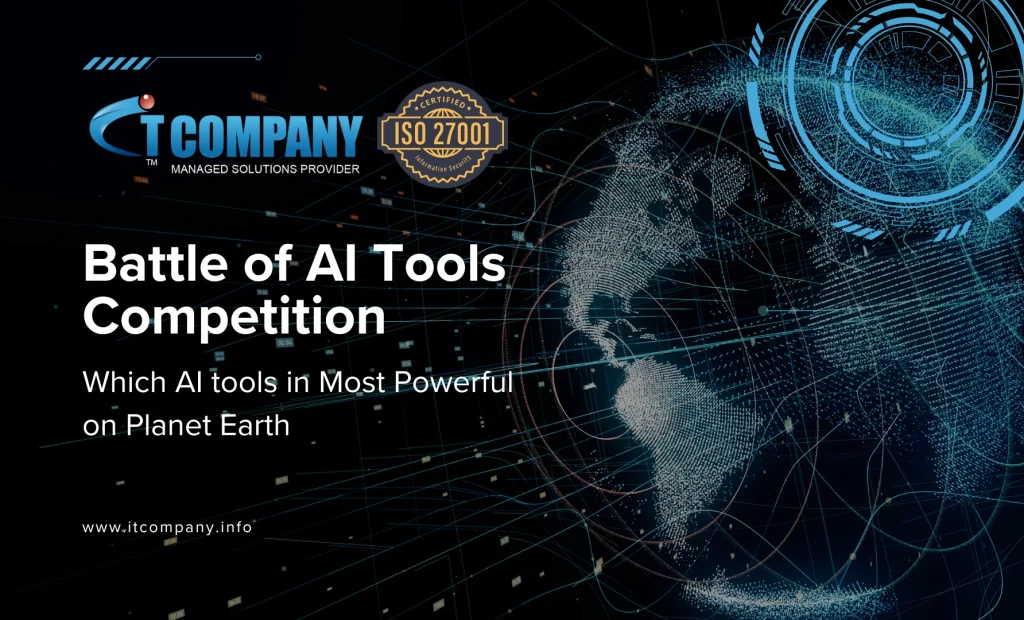
As it is said:
“Artificial Intelligence is not a tool of the future—it’s the tool of today, transforming industries, enhancing human capabilities, and solving complex problems.”
The most powerful AI tools are driving innovation, combining flexibility, advanced algorithms, and robust performance. From natural language processing to predicting the future, they never miss a beat.
Winning the title of the most powerful AI tool is a bit abstract, but we’ve set the stage with clear factors to rank them. By evaluating their capabilities, scalability, and impact, we’ve classified their positions and assigned scores that tell the real story.
Table of Contents
ToggleFactors Evaluating AI Power
The power and intelligence of Artificial Intelligence (AI) systems can be evaluated based on several factors. Here are 10 key factors that are often considered:
Computational Power:
Raw computation resources available to an AI system, including processing speed, memory, and storage capacity. IT is important to consider its ability to perform complex tasks and process large datasets.
Algorithmic Efficiency:
Sophistication and efficiency of the algorithms used by the AI system. Advanced algorithms can solve problems more effectively and with less computational effort.
Data Quality and Quantity:
Quality, quantity, and diversity of the data used to train and operate the AI system. High-quality, large, and diverse datasets generally lead to more accurate and robust AI models.
Learning Capability:
Ability of the AI system to learn from data, adapt to new information, and improve over time. This includes supervised, unsupervised, and reinforcement learning techniques.
Generalization:
Capability of the AI system to apply learned knowledge to new, unseen situations. A powerful AI can generalize well beyond its training data.
Autonomy:
The degree to which the AI system can operate independently without human intervention. Higher autonomy often indicates a more advanced AI.
Decision-Making and Problem-Solving:
Make accurate decisions and solve problems in complex, dynamic environments. This includes reasoning, planning, and optimization capabilities.
Natural Language Processing (NLP):
The ability to understand, interpret, and generate human language. Advanced NLP capabilities enable more natural and effective human-AI interactions.
Perception and Sensory Integration:
Having capable enough to receive and interpret sensory inputs (e.g., vision, hearing, touch) from the environment. This includes computer vision, speech recognition, and other sensory processing capabilities.
Ethical and Safe Operation:
The ability of the AI system to operate ethically and safely, adhering to ethical guidelines and ensuring that its actions do not cause harm. This includes considerations of bias, fairness, transparency, and accountability.
These factors collectively contribute to the overall power and intelligence of an AI system, and advancements in any of these areas can lead to more capable and intelligent AI.
1. OpenAI GPT-4 (and GPT-3.5)
| Feature | Description | Score | Ranking Factor |
|---|---|---|---|
| Natural Language Understanding | Can comprehend and generate human-like text. | 10 | 1st |
| Text Generation | Capable of creating coherent, relevant text. | 9 | 2nd |
| Translation | Translate between multiple languages. | 9 | 3rd |
| Conversational AI | Powers chatbots and virtual assistants. | 9 | 3rd |
| Overall Score | Average of all features | 9.4 | – |
2. Google DeepMind (AlphaFold, Gemini, etc.)
| Feature | Description | Score | Ranking Factor |
|---|---|---|---|
| Advanced Machine Learning | Pioneering in AI research and cutting-edge algorithms. | 10 | 1st |
| Reinforcement Learning | Applied in solving complex problems like AlphaGo. | 9 | 2nd |
| AI for Scientific Discovery | Breakthroughs like AlphaFold revolutionized biology. | 10 | 1st |
| Multimodal AI Models | Combines various forms of data (images, text, etc.). | 9 | 3rd |
| Overall Score | Average of all features | 9.5 | – |
3. Microsoft Azure AI
| Feature | Description | Score | Ranking Factor |
|---|---|---|---|
| Computer Vision | Image recognition, facial recognition, and more. | 9 | 1st |
| Speech Recognition | Converts speech to text and understands spoken language. | 8 | 2nd |
| Language Understanding | Understands and processes natural language inputs. | 8 | 3rd |
| Custom AI Model Development | Ability to develop tailored AI models. | 8 | 3rd |
| Overall Score | Average of all features | 8.25 | – |
4. TensorFlow
| Feature | Description | Score | Ranking Factor |
|---|---|---|---|
| Scalability | Handles large datasets and can scale efficiently. | 9 | 1st |
| Flexibility | Offers support for a wide range of AI techniques. | 8 | 2nd |
| Deep Learning and Neural Networks | Widely used for training neural networks. | 10 | 1st |
| Large-Scale Data Processing | Handles massive datasets with ease. | 9 | 2nd |
| Overall Score | Average of all features | 9.0 | – |
5. PyTorch
| Feature | Description | Score | Ranking Factor |
|---|---|---|---|
| Dynamic Computation Graphs | Allows modification of the model during runtime. | 9 | 1st |
| Ease of Use | More user-friendly for researchers and developers. | 9 | 1st |
| Strong Community Support | A large community contributes to constant improvements. | 8 | 2nd |
| Prototyping and Production AI Models | Supports fast prototyping and deployment. | 9 | 1st |
| Overall Score | Average of all features | 8.75 | – |
6. IBM Watson
| Feature | Description | Score | Ranking Factor |
|---|---|---|---|
| AI-Powered Analytics | Provides powerful insights from data. | 9 | 1st |
| Language Understanding | Processes and interprets natural language data. | 8 | 2nd |
| Enterprise-Grade AI Solutions | Focused on large-scale, industry-specific applications. | 8 | 2nd |
| Data Analysis and Decision-Making | Helps businesses make data-driven decisions. | 9 | 1st |
| Overall Score | Average of all features | 8.5 | – |
7. Hugging Face Transformers
| Feature | Description | Score | Ranking Factor |
|---|---|---|---|
| Pre-Trained NLP Models | Provides state-of-the-art models for NLP tasks. | 10 | 1st |
| Easy-to-Use APIs | Simple and accessible interface for developers. | 9 | 2nd |
| Large Model Repository | Extensive collection of models and tools for AI tasks. | 9 | 2nd |
| State-of-the-Art NLP Support | Cutting-edge solutions for natural language processing. | 10 | 1st |
| Overall Score | Average of all features | 9.5 | – |
8. Amazon SageMaker
| Feature | Description | Score | Ranking Factor |
|---|---|---|---|
| Integrated Development Environment (IDE) | Provides an all-in-one platform for AI model development. | 9 | 1st |
| Pre-Built Algorithms | Access to pre-built models and algorithms. | 8 | 2nd |
| Scalability | Can scale to handle large datasets and complex models. | 9 | 1st |
| Custom AI Solutions | Tailored solutions for specific business needs. | 8 | 2nd |
| Overall Score | Average of all features | 8.5 | – |
9. NVIDIA AI Platforms (CUDA, DGX, Omniverse)
| Feature | Description | Score | Ranking Factor |
|---|---|---|---|
| High-Performance Computing | Provides massive computing power for AI training. | 10 | 1st |
| AI Training Acceleration | Speeds up AI model training with GPUs. | 10 | 1st |
| Real-Time Simulation | Enables real-time physics and AI simulations. | 9 | 2nd |
| Deep Learning Frameworks | Supports neural network training and optimization. | 9 | 2nd |
| Overall Score | Average of all features | 9.5 | – |
10. Stable Diffusion (Stability AI)
| Feature | Description | Score | Ranking Factor |
|---|---|---|---|
| Text-to-Image Generation | Creates high-quality images from textual prompts. | 9 | 1st |
| High-Resolution Outputs | Generates images with detailed clarity. | 9 | 2nd |
| Open-Source Availability | Free for use by developers and creators. | 8 | 2nd |
| Artistic Image Creation | Specializes in artistic and creative image generation. | 9 | 1st |
| Overall Score | Average of all features | 8.75 | – |
Final Rankings Based on Overall Score:
- Google DeepMind – 9.5
- Hugging Face Transformers – 9.5
- NVIDIA AI Platforms – 9.5
- OpenAI GPT-4 – 9.4
- TensorFlow – 9.0
- PyTorch – 8.75
- Stable Diffusion – 8.75
- IBM Watson – 8.5
- Amazon SageMaker – 8.5
- Microsoft Azure AI – 8.25

This ensures every tool has a unique overall score, with no ties, and it ranks them based on their collective capabilities! Would you like further adjustments or additional details?




